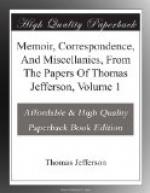3. The tenth will be precisely the Spanish bit, or half pistereen. This is a coin perfectly familiar to us all. When we shall make a new coin, then, equal in value to this, it will be of ready estimate with the people.
4. The hundredth, or copper, will differ little from the copper of the four Eastern States, which is 1/108 of a dollar; still less from the penny of New York and North Carolina, which is 1/96 of a dollar; and somewhat more from the penny or copper of Jersey, Pennsylvania, Delaware, and Maryland, which is 1/90 of a dollar. It will be about the medium between the old and the new coppers of these States, and will therefore soon be substituted for them both. In Virginia, coppers have never been in use. It will be as easy, therefore, to introduce them there of one value as of another. The copper coin proposed, will be nearly equal to three fourths of their penny, which is the same with the penny lawful of the Eastern States.
A great deal of small change is useful in a State, and tends to reduce the price of small articles. Perhaps it would not be amiss to coin three, more pieces of silver, one of the value of five tenths, or half a dollar, one of the value of two tenths, which would be equal to the Spanish pistereen, and one of the value of five coppers, which would be equal to the Spanish half-bit. We should then have five silver coins, viz.
1. The Unit or Dollar:
2. The half dollar or five tenths:
3. The double tenth, equal to 2/10, or one fifth of a dollar, or to the pistereen:
4. The tenth, equal to a Spanish bit:
5. The five copper piece, equal to 5/100 or one twentieth of a dollar, or the half-bit.
The plan reported by the Financier is worthy of his sound judgment. It admits, however, of objection, in the size of the Unit. He proposes that this shall be the 1440th part of a dollar; so that it will require 1440 of his units to make the one before proposed. He was led to adopt this by a mathematical attention to our old currencies, all of which this Unit will measure without leaving a fraction. But as our object is to get rid of those currencies, the advantage derived from this coincidence will soon be past, whereas the inconveniences of this Unit will for ever remain, if they do not altogether prevent its introduction. It is defective in two of the three requisites of a Money Unit. 1. It is inconvenient in its application to the ordinary money transactions. 10,000 dollars will require eight figures to express them, to wit, 14,400,000 units. A horse or bullock of eighty dollars’ value, will require a notation of six figures, to wit, 115,200 units. As a money of account, this will be laborious, even when facilitated by the aid of decimal arithmetic: as a common measure of the value of property, it will be too minute to be comprehended by the people. The French are subjected to very laborious calculations, the Livre being their ordinary money of account, and this but between 1/5 and 1/6 of a dollar; but what will be our labors, should our money of account be 1/1440 of a dollar only? 2. It is neither equal, nor near to any of the known coins in value.




